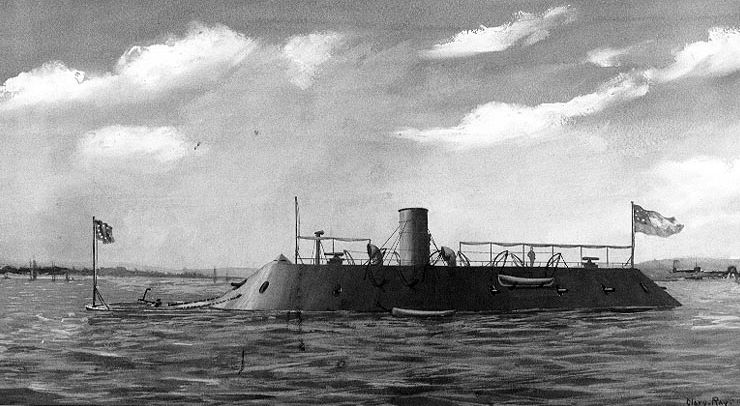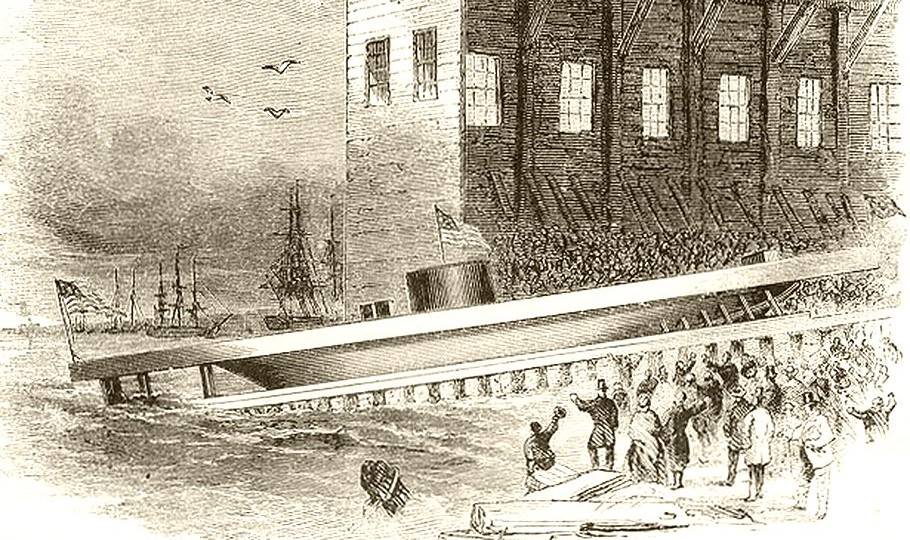The Battle of Hampton Roads remembered as the first clash between ironclad warships, marked a revolutionary moment in naval warfare. This historic encounter unfolded on March 8th and 9th, 1862, during the American Civil War. In the waters of Virginia, two ironclads, the Union’s USS Monitor and the Confederacy’s CSS Virginia, faced off in an unprecedented naval duel. Their meeting not only changed the course of the Civil War but also signaled a new era in military maritime history.
The Capture and Transformation of CSS Virginia
At the onset of the American Civil War, the Confederacy seized a significant asset that would later become the CSS Virginia. Originally built as the USS Merrimack, a frigate of the United States Navy, this vessel was captured in April 1861 when Union forces abandoned the Norfolk Navy Yard. Recognizing its potential, the Confederates embarked on an ambitious project to convert the abandoned frigate into a formidable ironclad.

The transformation of the USS Merrimack into the CSS Virginia was a groundbreaking endeavor. The Confederates outfitted the wooden hull with iron armor, making it impervious to traditional naval artillery. Renamed CSS Virginia, this reimagined warship was a marvel of innovation, reflecting the Confederacy’s resourcefulness and engineering prowess. Its completion marked a turning point in naval warfare, setting the stage for the historic battle at Hampton Roads.
The Genesis and Ingenuity of USS Monitor
The USS Monitor, a novel warship of the Union Navy, was the brainchild of John Ericsson, a visionary inventor and engineer. Unlike traditional naval vessels, the Monitor boasted a unique design featuring a revolving turret, a concept that was revolutionary for its time. This innovation allowed it to fire in multiple directions, a significant advantage over conventional broadside warships. Commissioned in response to the threat posed by the CSS Virginia, the Monitor represented the Union’s urgency and ingenuity in naval technology.

Constructed in Brooklyn, New York, the USS Monitor was built with speed and secrecy to counter the Confederate ironclad threat. Launched on January 30, 1862, this ironclad was a marvel of industrial prowess, embodying the North’s industrial capabilities. Its low profile, iron-armored hull, and innovative turret made it a formidable opponent against the Virginia. The Monitor’s creation not only demonstrated the Union’s technological advancement but also symbolically underscored the North’s industrial superiority during the Civil War.
The Prelude to the Ironclad Battle
Before the historic clash of ironclads at Hampton Roads, the Union had established a stringent blockade of Confederate ports, a key strategy in their effort to squeeze the Southern economy and war effort. The CSS Virginia, equipped with iron armor and heavy guns, was the Confederacy’s answer to break this blockade. Under the command of Captain Franklin Buchanan, the Virginia set out on its maiden voyage with a mission to challenge the Union’s naval dominance.

On March 8, 1862, the Virginia made its dramatic entry into the battle, targeting the Union blockading squadron. Captain Buchanan, an experienced and determined leader, guided the Virginia into a direct confrontation with the USS Cumberland and the USS Congress. The ironclad’s formidable iron armor and powerful artillery proved devastating. In a display of sheer firepower, the Virginia rammed and sunk the Cumberland, causing it to quickly take on water and capsize. Following this, it engaged the Congress, setting it ablaze with relentless cannon fire. The success of the Virginia under Buchanan, and later under Lieutenant Catesby ap Roger Jones after Buchanan was wounded, showcased the lethal effectiveness of ironclad ships and set the stage for the monumental encounter with the USS Monitor the following day.
The Clash of Ironclads: A Naval Standoff
The encounter between the USS Monitor and CSS Virginia on March 9, 1862, was a seminal moment in naval history. After Virginia’s destructive sortie on the previous day, the Monitor arrived to confront the Confederate ironclad, setting the stage for an unprecedented battle. The two ironclads, embodying the pinnacle of naval engineering of their time, engaged in a close-range duel that lasted several hours in the waters of Hampton Roads.
This battle was a grueling test of endurance and strategy. The Monitor, with its innovative revolving turret, tried to exploit its ability to fire in multiple directions, while the Virginia used its formidable ram and powerful broadsides. They circled and exchanged heavy fire, but their iron armor proved largely impervious to the other’s cannonballs. The crews faced immense challenges, including limited visibility, mechanical difficulties, and the exhausting task of operating the heavy guns. As the battle wore on, neither side could gain a decisive advantage. The clash was a gritty display of naval resilience and tactical ingenuity.

Eventually, both sides withdrew, each claiming victory. The Monitor had succeeded in protecting the Union fleet and preventing the Virginia from breaking the blockade. Meanwhile, the Confederacy celebrated the Virginia’s ability to stand toe-to-toe with the Union’s technological marvel. The battle ended without a clear winner, but it forever changed naval warfare, ushering in the era of armored warships and ending the dominance of wooden naval vessels.
The Global Impact and Legacy of the Battle
The Battle of Hampton Roads had a profound and lasting impact on naval warfare and shipbuilding worldwide. As the first engagement between ironclad warships, it demonstrated the obsolescence of wooden naval vessels and marked the beginning of a new era in naval engineering. The success of the ironclads in this battle caught the attention of major naval powers globally, leading to a significant shift in naval strategies and shipbuilding practices.
In the wake of the battle, Great Britain, France, Russia, and other maritime nations quickly recognized the implications of ironclad technology. They began to invest heavily in the development of their own ironclad fleets, understanding that to maintain naval superiority, they needed to adapt to this new paradigm. The sight of wooden ships being effortlessly destroyed by ironclads was a clear signal that the age of wooden warships had ended.
The Union, realizing the strategic advantage of ironclads, ordered the construction of an additional twenty such vessels. This decision underscored a broader shift in naval tactics and technology, moving away from traditional wooden ships to more resilient and heavily armed ironclads. This transformation was not just about the ships themselves but also about adopting new technologies and strategies to maximize their effectiveness in combat.
The Battle of Hampton Roads thus catalyzed a global arms race in naval technology. It influenced naval architecture and strategy for decades to come, with countries around the world racing to build fleets of these powerful new warships. The legacy of this battle extended far beyond the American Civil War, reshaping the future of naval warfare on a global scale.
Historical Challenge: Can You Conquer the Past?
Answer more than 18 questions correctly, and you will win a copy of History Chronicles Magazine Vol 1! Take our interactive history quiz now and put your knowledge to the test!

